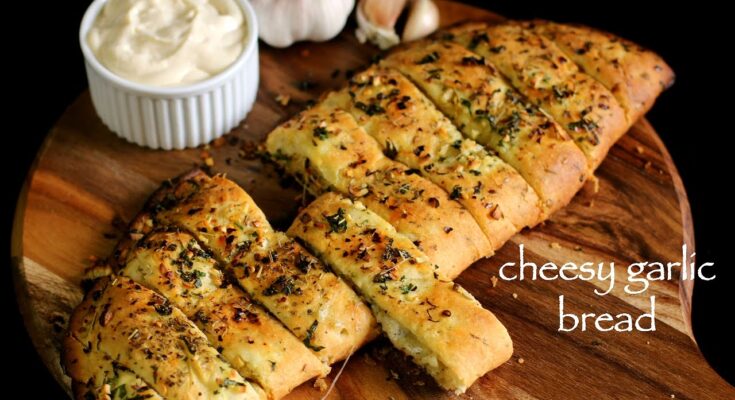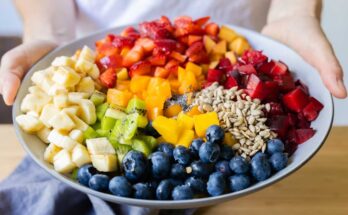Best Garlic Bread Recipe: There’s something magical about the aroma of garlic bread wafting through your kitchen. It’s the kind of smell that instantly transports you to a cozy Italian restaurant or a Sunday family dinner. But let’s be honest—store-bought versions rarely do justice to the real deal. The beauty of garlic bread lies in its simplicity: crusty bread, creamy butter, and a punch of garlic. Yet, getting it just right requires the perfect balance of ingredients, technique, and a little kitchen love.
Whether you’re preparing it as a side for pasta night, an appetizer for guests, or just because you’re craving something indulgent, this step-by-step guide will walk you through the best garlic bread recipe out there. From selecting the freshest ingredients to getting that perfect golden crunch, we’ll cover every detail you need to turn a basic loaf into a mouthwatering masterpiece.
Let’s dive in and make garlic bread that’s not just good, but unforgettable.
Ingredients You’ll Need
The secret to the best garlic bread lies in the quality of its ingredients. Simple doesn’t have to mean boring—especially when each component is chosen with care. Here’s a breakdown of everything you’ll need:
Essential Ingredients
- Bread – Preferably a crusty French baguette or Italian loaf. Avoid soft sandwich bread.
- Garlic – Fresh garlic cloves, not the pre-minced kind. The flavor is far more robust.
- Butter – Use unsalted, high-quality butter. If using salted, reduce added salt later.
- Parsley – Fresh flat-leaf parsley adds color and freshness.
- Salt – A pinch enhances all the flavors.
- Olive Oil – Optional, but adds richness and helps the bread crisp up.
- Parmesan or Mozzarella – Optional for cheese lovers.
Optional Add-ons for Extra Flavor
- Chili flakes for a spicy kick
- Lemon zest for a touch of brightness
- Rosemary or thyme for earthy depth
- Truffle oil for a luxurious finish
Freshness is key. Fresh garlic has a deeper, more complex flavor than garlic powder or pre-minced jars. Real butter trumps margarine every time. And herbs straight from the garden or market give that final touch of authenticity.
Stocking up on these ingredients ensures your garlic bread will be more than just a side—it’ll be the star of the meal.
Choosing the Right Bread
When it comes to garlic bread, the choice of bread can make or break your recipe. You want a loaf that can hold up to the buttery spread without turning soggy, yet one that also gets delightfully crispy in the oven.
Best Types of Bread
- French Baguette – Its dense crust and airy interior make it a top pick.
- Italian Loaf (Ciabatta) – Great for its soft inside and crisp exterior.
- Sourdough – Adds a tangy depth of flavor and chewy texture.
- Artisan Loaves – As long as they’re crusty and firm.
Why Bread Texture Matters
A good loaf should be sturdy. Soft sandwich bread, while convenient, tends to go limp and greasy. You want something that can take on the garlicky butter, crisp up nicely in the oven, and give that satisfying crunch when you bite into it.
Avoid overly sweet breads or those with additives like raisins or herbs already baked in. They can clash with the flavors you’re trying to highlight.
Homemade vs. Store-Bought Bread
If you’re a baking enthusiast, making your own loaf can elevate your garlic bread to new heights. However, don’t shy away from high-quality store-bought options. Look for local bakery loaves or fresh-baked sections at your grocery store.
Whichever you choose, make sure the bread is fresh but not too soft. Day-old bread actually works beautifully since it holds up better to the butter mixture and crisps up more evenly in the oven.
Preparing the Garlic Butter
This is where the magic happens. Garlic butter is the heart and soul of your recipe. Done right, it can infuse every bite with rich, aromatic flavor.
Step-by-Step Garlic Butter Recipe
- Mince the Garlic – Finely mince 4–6 cloves. For a milder flavor, roast the garlic first.
- Soften the Butter – Let a stick of unsalted butter sit at room temperature until soft.
- Mix in Fresh Herbs – Add 2 tablespoons of finely chopped parsley.
- Season – Sprinkle in a pinch of salt and pepper.
- Add Extras (Optional) – A teaspoon of olive oil, a pinch of chili flakes, or a handful of grated parmesan cheese can take it to the next level.
Roasted vs. Raw Garlic
Raw garlic gives that sharp, pungent flavor. If you’re into bold tastes, go for it. For something smoother and slightly sweet, roast your garlic first:
- Slice the top off a bulb of garlic
- Drizzle with olive oil
- Wrap in foil and roast at 400°F (200°C) for 30–40 minutes
The result? Creamy cloves that mash right into the butter and melt into the bread like a dream.
Mixing Tips
Use a fork or hand mixer to whip the butter. This aerates it slightly, making it easier to spread and helping the herbs and garlic distribute evenly.
Don’t skimp on the butter. You want each slice soaked in garlicky goodness, not a dry bite in sight.
Assembling and Baking the Garlic Bread
Now that your garlic butter is ready and your bread is chosen, it’s time to put it all together. This is where your kitchen starts smelling absolutely divine. The assembly process is simple, but every step counts to get that perfect golden-brown crust and melt-in-your-mouth center.
Step-by-Step Assembly
- Slice the Bread – Cut your loaf in half lengthwise or into thick slices, depending on your preference. For a pull-apart experience, go with individual slices.
- Spread Generously – Use a spoon or spatula to slather the garlic butter over each piece. Be generous. You want the butter to soak into the bread a bit but not so much that it pools.
- Optional Cheese Layer – Sprinkle grated mozzarella or parmesan on top if you like your garlic bread cheesy.
- Wrap or Bake Open – For softer garlic bread, wrap it in aluminum foil. For a crispier finish, bake it open-faced.
Baking Time and Temperature
Preheat your oven to 375°F (190°C). If you’re baking it wrapped in foil, go for 15–20 minutes. If open-faced, 10–12 minutes should do, but then broil for an extra 1–2 minutes for that crispy, golden top.
Keep an eye on it. Burnt garlic can taste bitter, and you don’t want all your effort to go to waste right at the finish line.
Tips for Perfect Texture
- For soft garlic bread: Wrap it in foil so it stays moist.
- For crispy garlic bread: Leave it uncovered or broil it for the last few minutes.
- For a cheesy crust: Use mozzarella for gooeyness and parmesan for a crispy top.
Don’t forget to let it rest for a minute before cutting or serving. Hot butter needs time to settle, and it gives the bread a better structure.
Serving Suggestions
Garlic bread is incredibly versatile, making it the perfect companion to a wide variety of dishes. While it shines as a side, you can turn it into a main dish or even dessert with some creativity.
Classic Pairings
- Pasta – Especially spaghetti, lasagna, and creamy Alfredo dishes.
- Soups and Stews – Perfect for dipping into tomato soup, minestrone, or beef stew.
- Salads – Caesar salad or Caprese salad complements garlic bread beautifully.
Creative Serving Ideas
- Garlic Bread Sandwiches – Slice and stuff with grilled chicken, melted cheese, or veggies.
- Appetizer Platter – Serve mini garlic bread slices with dipping sauces like marinara or pesto.
- Breakfast Toast – Top with scrambled eggs, bacon, or even avocado for a savory twist.
Make It a Meal
Want to turn garlic bread into the star of your dinner? Add some grilled proteins and a fresh salad on the side. Or make garlic bread pizza by adding tomato sauce and toppings before baking.
No matter how you serve it, garlic bread adds a cozy, comforting touch to any table.
Variations of Garlic Bread
One of the best parts about garlic bread is how customizable it is. Once you master the classic version, feel free to explore different flavors and formats to suit your taste buds.
Cheesy Garlic Bread
- Add shredded mozzarella or cheddar before baking.
- Try a mix of cheeses like provolone, fontina, and parmesan for a gourmet version.
Spicy Garlic Bread
- Mix red pepper flakes or a splash of hot sauce into your butter.
- Serve with a spicy marinara for dipping.
Herb-Loaded Garlic Bread
- Use a mix of fresh herbs like oregano, basil, chives, and thyme.
- Add a drizzle of herbed olive oil before serving.
Vegan Garlic Bread
- Swap butter for vegan butter or olive oil.
- Use nutritional yeast instead of cheese for a cheesy flavor.
Sweet Garlic Bread (Yes, really!)
- Roast garlic until it’s super sweet.
- Mix with honey and butter for a slightly sweet-savory combo.
These variations let you tailor your garlic bread to different cuisines, from Italian to Mexican, or even something uniquely your own.
How to Store and Reheat Garlic Bread
Garlic bread is best enjoyed fresh out of the oven, but don’t worry—leftovers can still be delicious if stored and reheated properly.
Storing Garlic Bread
- Room Temperature: Store in foil or an airtight container for up to 1 day.
- Refrigerator: Not ideal, as it dries out the bread quickly.
- Freezer: Wrap tightly in plastic wrap and foil, then freeze for up to 3 months.
Reheating Tips
- Oven: Preheat to 350°F (175°C), wrap in foil, and bake for 10–15 minutes.
- Toaster Oven: Great for getting that crispy edge back.
- Microwave (last resort): Wrap in a damp paper towel and microwave for 20–30 seconds. It won’t be as crispy but still tasty.
Make-Ahead Garlic Bread
You can even prep garlic bread ahead of time. Assemble the bread with garlic butter, wrap tightly, and refrigerate or freeze until ready to bake.
Perfect for busy weeknights, entertaining guests, or satisfying those late-night cravings!
Common Mistakes to Avoid
Even though garlic bread is simple, there are a few pitfalls that can ruin its potential. Avoiding these common mistakes ensures that your garlic bread turns out perfect every time.
Using Low-Quality Butter or Garlic
This one’s a dealbreaker. If your butter is overly processed or your garlic is from a jar, the flavor just won’t be the same. Always opt for fresh garlic and real butter.
Overloading the Bread
Too much garlic butter might sound like a good idea, but it can lead to soggy, greasy bread. It’s better to apply a generous but even layer that seeps into the bread without drowning it.
Burning the Garlic
Garlic burns fast, especially under a broiler. Once it’s burnt, it turns bitter and ruins the taste. If you’re broiling, do so for only a minute or two and keep your eye on it.
Using the Wrong Bread
Soft white bread or anything pre-sliced is usually too delicate and will fall apart under the weight of the butter. Always go for a crusty, sturdy loaf.
Skipping the Broil (or Over-Broiling)
The broiler gives you that golden, bubbly top, but it’s a double-edged sword. Too little and it stays pale, too much and you’ve got a charcoal mess. Find the balance—1 to 2 minutes max!
Avoid these missteps, and you’ll be well on your way to garlic bread perfection.
Tips for Making Garlic Bread for a Crowd
Hosting a dinner party or feeding a large family? Garlic bread is your go-to side because it’s quick, filling, and universally loved. Here’s how to scale up your garlic bread game.
Use a Full Loaf or Two
Instead of slicing into pieces, slice loaves in half and apply garlic butter to each. Once baked, you can easily cut them into serving-sized slices.
Batch-Baking Method
- Preheat the oven.
- Prep several loaves ahead of time.
- Wrap in foil and place multiple loaves on large baking trays.
- Rotate trays halfway through for even baking.
Serve in a Warm Basket
Use a cloth-lined basket to keep slices warm. You can also use a slow cooker on the “warm” setting to keep larger batches hot without drying them out.
Make It Interactive
Let your guests add their own toppings—set up a garlic bread station with extras like cheese, herbs, chili flakes, and dips. It’s fun, festive, and guarantees everyone gets exactly what they like.
Whether it’s a cozy family dinner or a buffet-style feast, garlic bread made in bulk can still taste homemade and fresh with the right approach.
Garlic Bread Dips and Sauces
Pairing garlic bread with the right dip or sauce can elevate it from a simple side to a flavor-packed appetizer. Here are some of the best sauces that make garlic bread even more irresistible.
Classic Marinara
Rich, tomato-based marinara is a match made in heaven with garlic bread. It’s great for dipping or even drizzling over cheesy slices.
Garlic Aioli
For those who can’t get enough garlic, garlic aioli brings a creamy, zesty kick that intensifies the flavor.
Pesto
Fresh basil pesto adds a herby twist with a hint of nuttiness. It’s bold, vibrant, and works beautifully with garlic and butter.
Cheese Sauce
Melted mozzarella or a creamy cheddar cheese dip turns garlic bread into a decadent snack.
Ranch or Blue Cheese
Not traditional, but absolutely satisfying. These dips work well if you’re serving garlic bread alongside wings or as part of a snack spread.
Bonus: Spicy Tomato Salsa
Add some heat with a fresh tomato salsa infused with chili and herbs. It’s perfect for those who like it fiery.
These pairings add variety to your table and make garlic bread suitable for more than just Italian night.
Making Gluten-Free or Keto Garlic Bread
Don’t worry if you’re avoiding gluten or carbs—you can still enjoy a delicious version of garlic bread that fits your lifestyle.
Gluten-Free Garlic Bread
Use a high-quality gluten-free loaf (look for ones that are firm and crusty). Everything else remains the same:
- Use garlic butter as usual
- Bake at 375°F
- Watch carefully, as gluten-free bread tends to brown faster
Keto Garlic Bread
Swap traditional bread with:
- Fathead dough (mozzarella-based dough)
- Cauliflower bread (made from riced cauliflower and cheese)
Follow the same garlic butter method, then bake until golden and crispy. While it won’t be exactly the same, it’s a solid, satisfying substitute for anyone cutting carbs.
You don’t have to miss out on garlic bread just because you’re watching your diet. These smart swaps keep the flavor while ditching the carbs or gluten.
FAQs About the Best Garlic Bread Recipe
1. What is the best type of bread to use for garlic bread?
French bread or Italian loaf is ideal. They’re sturdy enough to hold the buttery garlic topping and have that perfect soft-inside, crispy-outside texture.
2. Can I use garlic powder instead of fresh garlic?
Yes, but fresh garlic delivers a bolder, more aromatic flavor. Garlic powder works in a pinch, especially for a smoother spread.
3. How do I store leftover garlic bread?
Wrap it in foil or store in an airtight container. Refrigerate for up to 3 days. Reheat in the oven or air fryer to get it crispy again.
4. Can I make garlic bread ahead of time?
Absolutely. You can prepare it up to a day in advance, wrap it in foil, and refrigerate. Bake when you’re ready to serve.
5. What cheeses go best with garlic bread?
Mozzarella, parmesan, or a blend of both add richness and melt beautifully. For a twist, try cheddar or provolone.
6. Can I freeze garlic bread?
Yes! Assemble, wrap tightly in foil or plastic wrap, and freeze for up to 2 months. Bake straight from frozen at 375°F (190°C) until hot and golden.
7. How do I make garlic bread without an oven?
Use a skillet or stovetop griddle on medium heat. Cover with a lid to help it warm through while the bottom gets toasty.
Conclusion
Garlic bread isn’t just a side—it’s a statement. With its perfect balance of crunch, softness, butter, and garlic, it can elevate any meal or shine all on its own. This step-by-step guide has walked you through the best ways to make it, from choosing the right bread to creating your own garlic butter masterpiece. Whether you keep it classic, make it cheesy, or add your own twist, one thing’s for sure: your kitchen will smell amazing, and your guests (or just you!) will keep coming back for more.
Don’t be surprised if garlic bread becomes your new favorite kitchen staple. Once you’ve nailed the basics, the possibilities are endless.



